An Experimental Study on Strengthening Recycled Aggregates Considering Dry Mixing before Slurry Coating
Abstract
1. Introduction
2. Materials and Methods
2.1. Materials
2.2. Procedure to Strengthen Recycled Aggregates
- (1)
- Preparation of recycled aggregates: The aggregates are soaked in water for 24 h and then placed on a plastic mesh to allow the free water at the surface to drain. In this way, the fines used for dry mixing can be better attached to the pores and cracks in the recycled aggregates. Later, the recycled aggregates are evenly divided into four groups.
- (2)
- Dry mixing with fines: Three groups of the soaked aggregates are mixed with MSi (group A), UFFA (group B), and NCC (group C) in the blender, respectively, as shown in Figure 1a, until the surface of the aggregates is fully and evenly coated with fines. The remaining group (group D) of prepared aggregates is not mixed with any fines for comparison.
- (3)
- Curing after dry mixing: After spraying water over the four groups of dry-mixed recycled aggregates, they are spread on the ground for 3 days of curing, as shown in Figure 1b.
- (4)
- Removing excess fines in the aggregates: Figure 1c shows the procedure when excess fines are removed from the mixture with a sieve and collected for future use.
- (5)
- Preparation of solution for slurry coating: Three types of solution are prepared for coating the recycled aggregates per the concentration or water–cement ratio, illustrated in Section 2.1 (shown in Figure 1d).
- (6)
- Coating the recycled aggregates with the prepared solution (shown in Figure 1e): Each group of the dry-mixed recycled aggregates is first divided evenly into three parts, and each part is then coated with WG, the PVA solution, and CS, respectively. The recycled aggregates are retrieved after soaking in WG and the PVA solution for 24 h. However, the aggregates are taken immediately out of CS once they are fully stirred.
- (7)
- Curing after slurry coating: As shown in Figure 1f, the slurry-coated recycled aggregates are spread on the ground for 7 days at room temperature to allow the slurry to cure.
2.3. Tests of the Aggregate Properties
2.4. Scanning Electron Microscopy (SEM)
3. Results and Discussion
3.1. Water-Absorption Rate
3.2. Crushing Value
3.3. Apparent Density
3.4. Mechanism for the Strengthening of Recycled Aggregates
4. Conclusions
- (1)
- The proposed methodology to strengthen recycled aggregates by dry mixing before slurry coating can significantly change the water-absorption rate and improve the crushing value and apparent density of recycled aggregates. It is indicated that dry mixing with MSi and slurry coating with the PVA solution can significantly reduce the water-absorption rate, while dry mixing with MSi and slurry coating with CS can effectively increase the crushing resistance and apparent density of the recycled aggregates.
- (2)
- A high linear correlation is observed between the apparent density and the crushing value of the strengthened recycled aggregates. In general, a higher crushing value causes a lower apparent density.
- (3)
- Microscopic morphology of the strengthened recycled aggregates shows that dry-mixing fines can fill the voids and cracks and bond them after hydration. Slurry coating can further repair and strengthen the weak contact to improve the performance of the recycled aggregates.
Author Contributions
Funding
Institutional Review Board Statement
Informed Consent Statement
Data Availability Statement
Conflicts of Interest
References
- Feng, C.; Cui, B.; Huang, Y.; Guo, H.; Zhang, W.; Zhu, J. Enhancement technologies of recycled aggregate—Enhancement mechanism, influencing factors, improvement effects, technical difficulties, life cycle assessment. Constr. Build. Mater. 2022, 317, 126168. [Google Scholar] [CrossRef]
- Akbarnezhad, A.; Ong, K.C.G.; Tam, C.T.; Zhang, M.H. Effects of the parent concrete properties and crushing procedure on the properties of coarse recycled concrete aggregates. J. Mater. Civ. Eng. 2013, 25, 1795–1802. [Google Scholar] [CrossRef]
- Chai, S.; Fan, L.; Liang, H. Required jacking force for deviation rectification of inclined structures supported with rigid piles. Front. Earth Sci. 2022, 10, 998798. [Google Scholar] [CrossRef]
- Xiao, J.; Li, W.; Fan, Y.; Huang, X. An overview of study on recycled aggregate concrete in China (1996–2011). Constr. Build. Mater. 2012, 31, 364–383. [Google Scholar] [CrossRef]
- The Construction Waste Management Work Has Achieved Positive Results, Changing Waste into Treasure, and Making the Environment Better. Available online: https://www.mohurd.gov.cn/xinwen/gzdt/202112/20211209_763363.html (accessed on 15 October 2022). (In Chinese)
- Chai, S. Maximum height estimation for mine waste dumps. J. South. Afr. Inst. Min. Metall. 2022, 122, 579–586. [Google Scholar] [CrossRef]
- Martín-Morales, M.; Cuenca-Moyano, G.M.; Valverde-Espinosa, I.; Valverde-Palacios, I. Effect of recycled aggregate on physical-mechanical properties and durability of vibro-compacted dry-mixed concrete hollow blocks. Constr. Build. Mater. 2017, 145, 303–310. [Google Scholar] [CrossRef]
- Ying, J.; Han, Z.; Shen, L.; Li, W. Influence of parent concrete properties on compressive strength and chloride diffusion coefficient of concrete with strengthened recycled aggregates. Materials 2020, 13, 4631. [Google Scholar] [CrossRef]
- Yao, Y.; Li, J.; Liang, C.; Hu, X. Effect of coarse recycled aggregate on failure strength for asphalt mixture using experimental and dem method. Coatings 2021, 11, 1234. [Google Scholar] [CrossRef]
- Wang, J.; Zhang, J.; Cao, D.; Dang, H.; Ding, B. Comparison of recycled aggregate treatment methods on the performance for recycled concrete. Constr. Build. Mater. 2020, 234, 117366. [Google Scholar] [CrossRef]
- Ying, J.; Meng, Q.; Xiao, J. Effect of CO2-modified recycled aggregate on compressive strength of concrete. J. Build. Mater. 2017, 20, 277–282. [Google Scholar]
- Lei, B.; Li, W.; Tang, Z.; Li, Z.; Tam, V.W.Y. Effects of environmental actions, recycled aggregate quality and modification treatments on durability performance of recycled concrete. J. Mater. Res. Technol. 2020, 9, 13375–13389. [Google Scholar] [CrossRef]
- Yu, L.; Lv, S.; Zhao, Z.; Liu, Z. Effect of slurry coating modified methods on water absorption of recycled coarse aggregate. Coatings 2022, 12, 363. [Google Scholar] [CrossRef]
- Pedro, D.; de Brito, J.; Evangelista, L. Performance of concrete made with aggregates recycled from precasting industry waste: Influence of the crushing process. Mater. Struct. 2015, 48, 3965–3978. [Google Scholar] [CrossRef]
- Yunxia, L.; Chongji, Z. Strengthening technique of recycled concrete aggregate. Concrete 2006, 195, 74–77. [Google Scholar]
- Kim, H.-S.; Kim, B.; Kim, K.-S.; Kim, J.-M. Quality improvement of recycled aggregates using the acid treatment method and the strength characteristics of the resulting mortar. J. Mater. Cycles Waste Manag. 2017, 19, 968–976. [Google Scholar] [CrossRef]
- Tam, V.W.Y.; Tam, C.M.; Le, K.N. Removal of cement mortar remains from recycled aggregate using pre-soaking approaches. Resour. Conserv. Recycl. 2007, 50, 82–101. [Google Scholar] [CrossRef]
- Guo, H.; Shi, C.; Guan, X.; Zhu, J.; Ding, Y.; Ling, T.-C.; Zhang, H.; Wang, Y. Durability of recycled aggregate concrete—A review. Cem. Concr. Compos. 2018, 89, 251–259. [Google Scholar] [CrossRef]
- Kou, S.-C.; Zhan, B.-j.; Poon, C.-S. Use of a CO2 curing step to improve the properties of concrete prepared with recycled aggregates. Cem. Concr. Compos. 2014, 45, 22–28. [Google Scholar] [CrossRef]
- Al-Baghdadi, H.M. Experimental study on sulfate resistance of concrete with recycled aggregate modified with polyvinyl alcohol (PVA). Case Stud. Constr. Mater. 2021, 14, e00527. [Google Scholar] [CrossRef]
- Kou, S.-C.; Poon, C.-S. Properties of concrete prepared with PVA-impregnated recycled concrete aggregates. Cem. Concr. Compos. 2010, 32, 649–654. [Google Scholar] [CrossRef]
- Ollivier, J.P.; Maso, J.C.; Bourdette, B. Interfacial transition zone in concrete. Adv. Cem. Based Mater. 1995, 2, 30–38. [Google Scholar] [CrossRef]
- Kou, S.-c.; Poon, C.-s.; Agrela, F. Comparisons of natural and recycled aggregate concretes prepared with the addition of different mineral admixtures. Cem. Concr. Compos. 2011, 33, 788–795. [Google Scholar] [CrossRef]
- GB/T 14685-2022; Pebble and Crushed Stone for Construction. China Building Materials Council: Beijing, China, 2022.
- Wei, H.; Yan, H.; Zhu, Y.; Xu, P.; Wang, X. Research on the modification of chemical reinforcers to reclaimed coarse aggregates. J. Shandong Agric. Univ. (Nat. Sci. Ed.) 2021, 52, 1009–1016. [Google Scholar] [CrossRef]
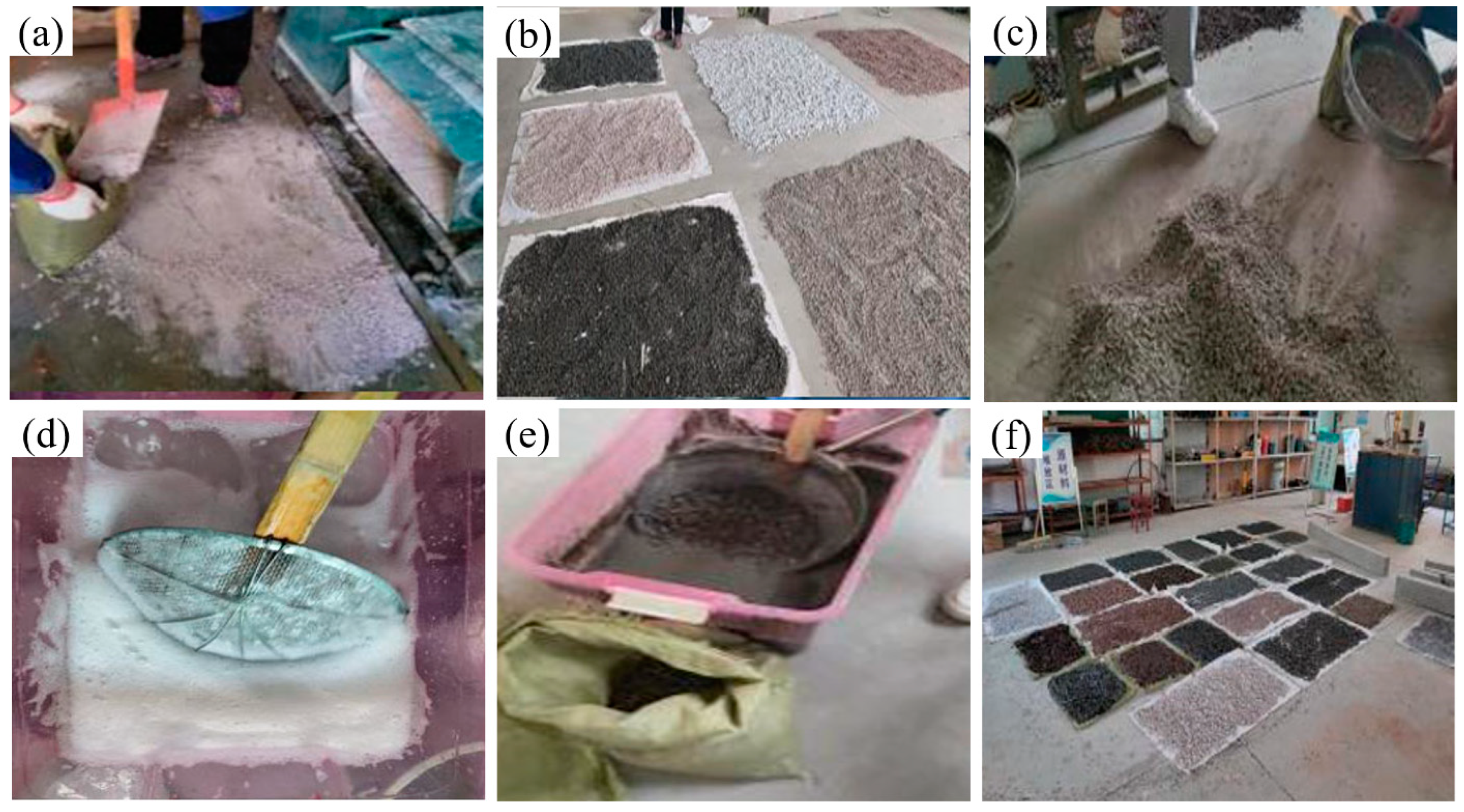
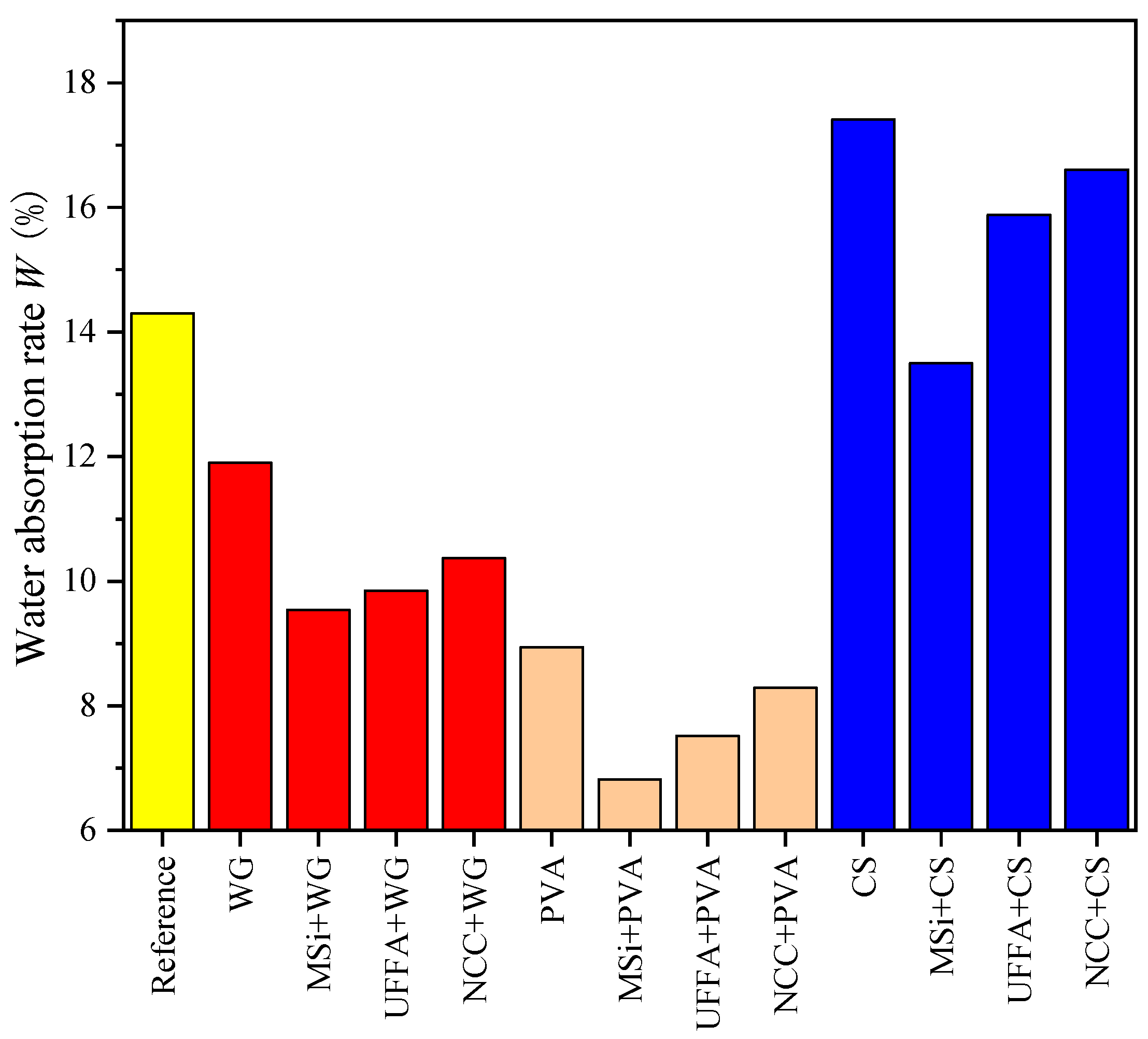
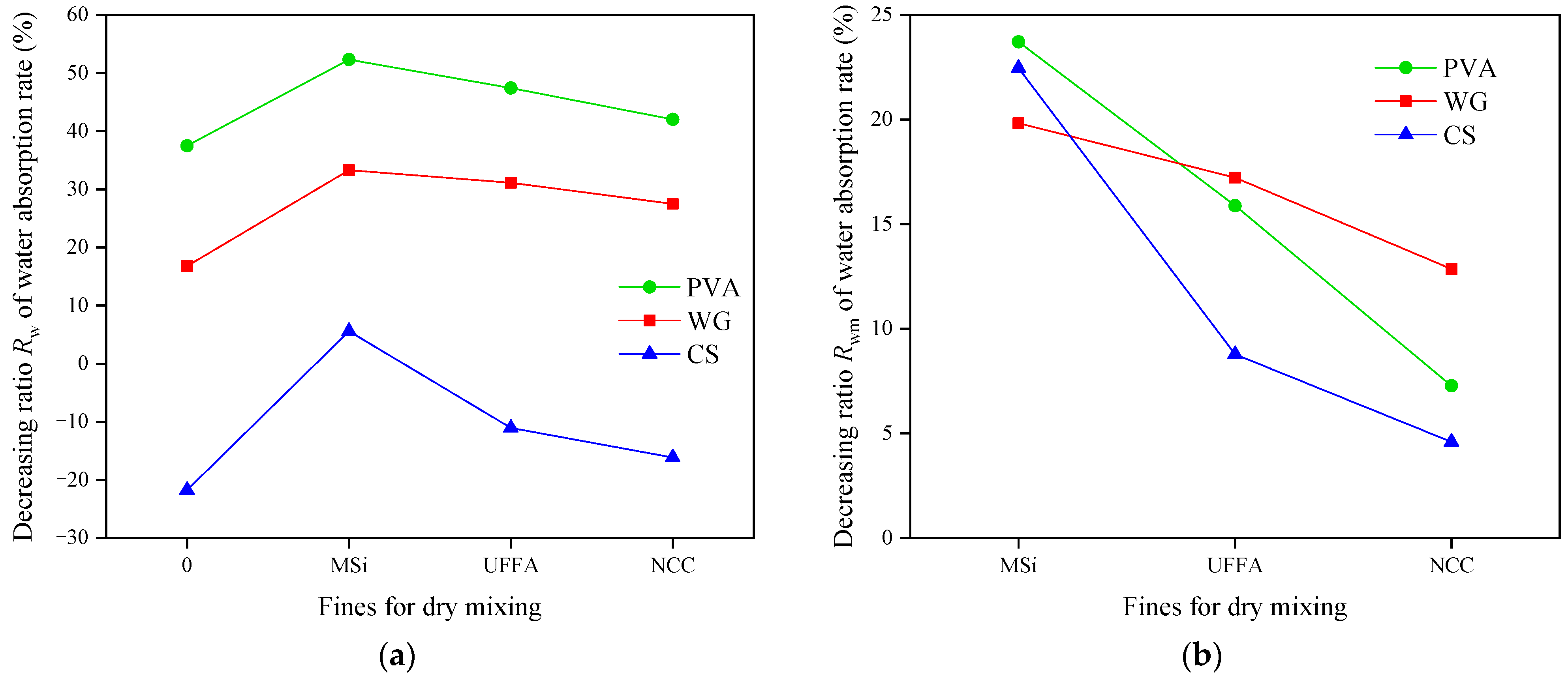
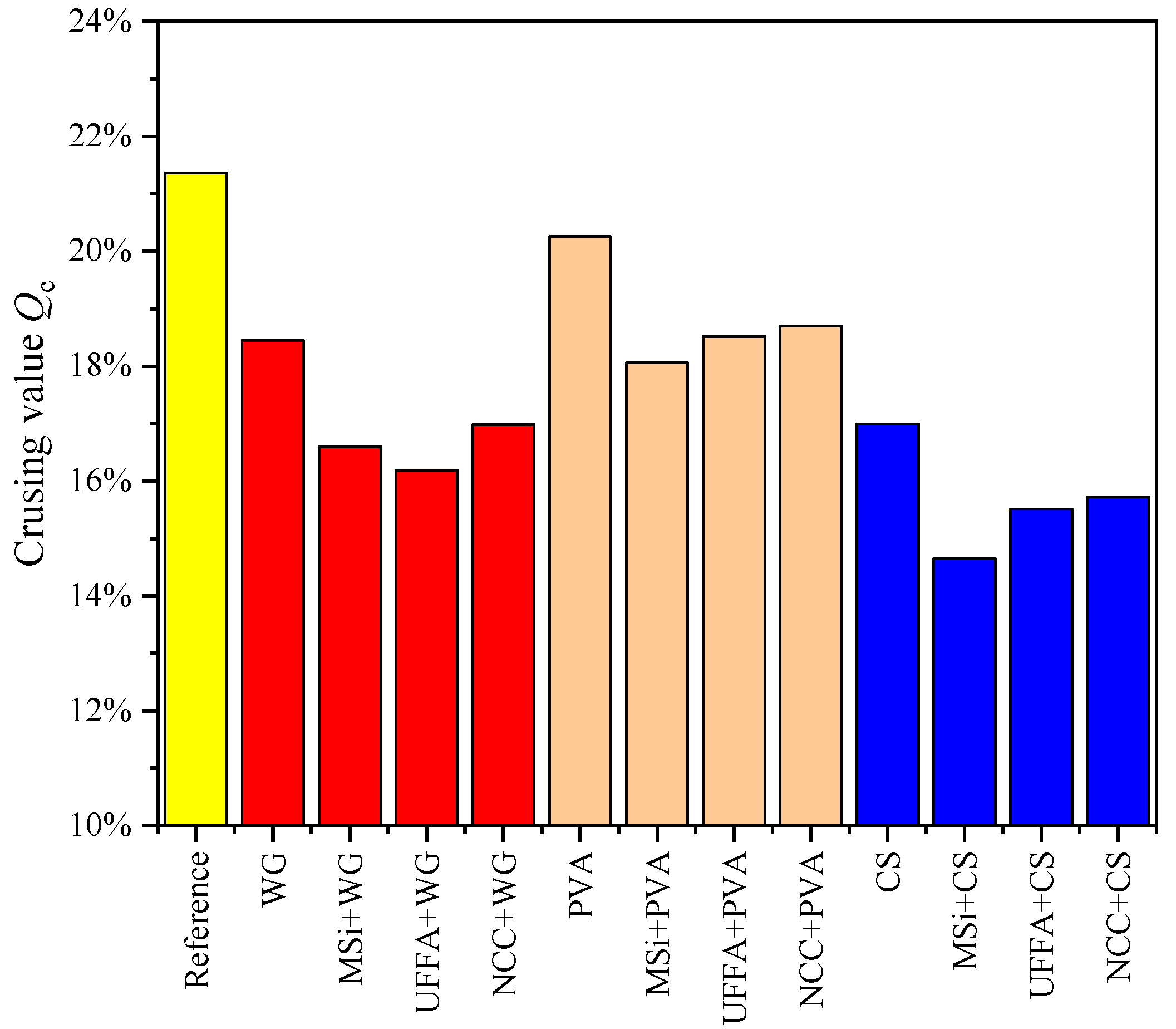
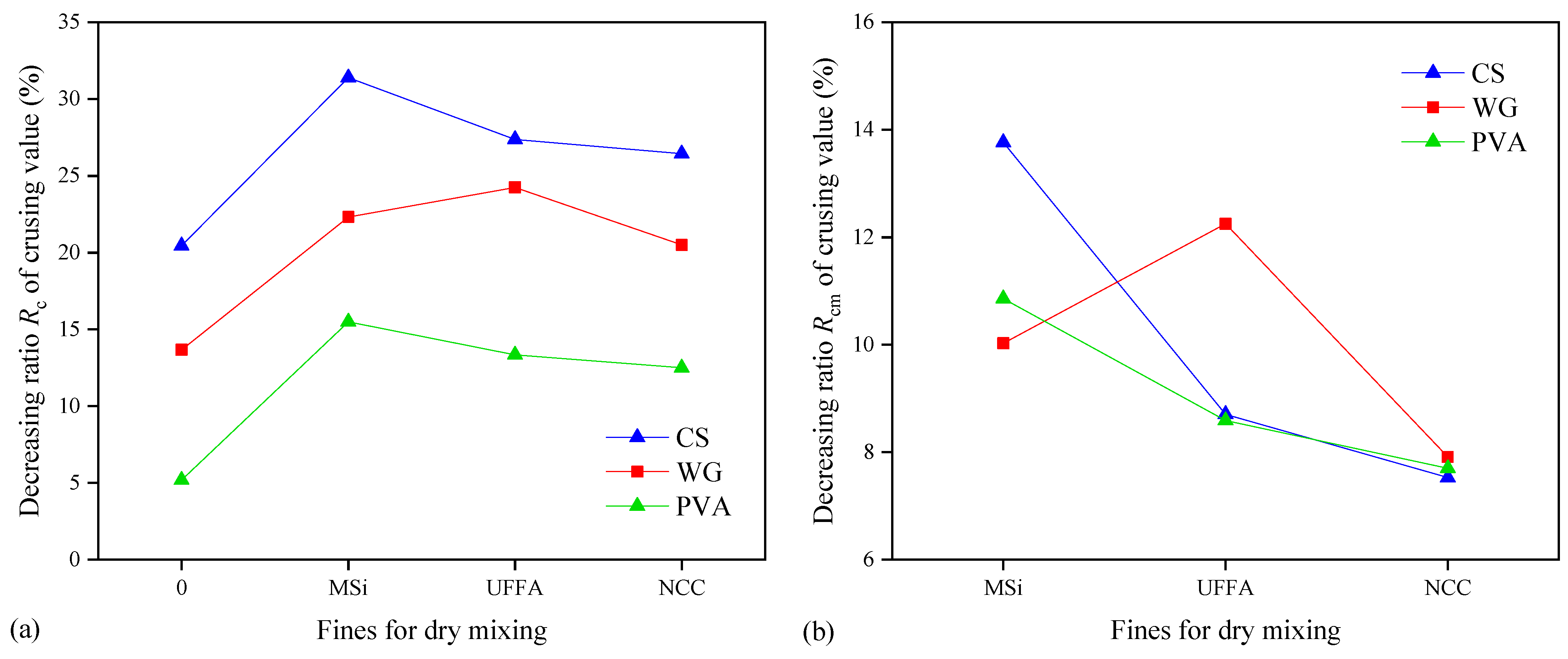



| Fines for Dry Mixing | SiO2 | Al2O3 | CaO | Fe2O3 | K2O | CaCO3 | Others |
|---|---|---|---|---|---|---|---|
| MSi | 96.6 | 0.35 | 1.28 | 1.35 | - | - | 0.42 |
| UFFA | 45.52 | 37.33 | 3.13 | 7.25 | 3.46 | 0.68 | 2.63 |
| NCC | - | - | - | - | - | 100 | - |
| Solution | 0 * | WG | PVA Solution | CS | |
|---|---|---|---|---|---|
| Fines | |||||
| 0 | Reference | WG | PVA | CS | |
| MSi | - | MSi + WG | MSi + PVA | MSi + CS | |
| UFFA | - | UFFA + WG | UFFA + PVA | UFFA + CS | |
| NCC | - | NCC + WG | NCC + PVA | NCC + CS | |
Publisher’s Note: MDPI stays neutral with regard to jurisdictional claims in published maps and institutional affiliations. |
© 2022 by the authors. Licensee MDPI, Basel, Switzerland. This article is an open access article distributed under the terms and conditions of the Creative Commons Attribution (CC BY) license (https://creativecommons.org/licenses/by/4.0/).
Share and Cite
Li, X.; Fan, L.; Chai, S. An Experimental Study on Strengthening Recycled Aggregates Considering Dry Mixing before Slurry Coating. Coatings 2022, 12, 1702. https://doi.org/10.3390/coatings12111702
Li X, Fan L, Chai S. An Experimental Study on Strengthening Recycled Aggregates Considering Dry Mixing before Slurry Coating. Coatings. 2022; 12(11):1702. https://doi.org/10.3390/coatings12111702
Chicago/Turabian StyleLi, Xiaomeng, Liujun Fan, and Shupeng Chai. 2022. "An Experimental Study on Strengthening Recycled Aggregates Considering Dry Mixing before Slurry Coating" Coatings 12, no. 11: 1702. https://doi.org/10.3390/coatings12111702
APA StyleLi, X., Fan, L., & Chai, S. (2022). An Experimental Study on Strengthening Recycled Aggregates Considering Dry Mixing before Slurry Coating. Coatings, 12(11), 1702. https://doi.org/10.3390/coatings12111702







